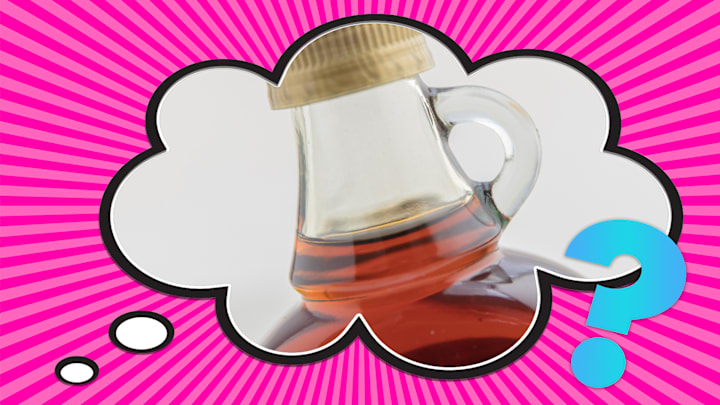Ideally, you’d be able to hold the handle of a maple syrup container while you carry it and also while you pour the syrup onto pancakes, waffles, or whatever other foodstuff calls for it. But the typical handle on a glass bottle of maple syrup is way too small and positioned too far up the bottleneck to be functional in either respect.
So, why is it there?
What’s a Skeuomorph?
The most widely accepted explanation is that the tiny handle is a skeuomorph, meaning “an ornament or design representing a utensil or implement,” per Merriam-Webster. In other words, a given item has a design element—a skeuomorph—that might help you recognize what the item is or should be used for, but doesn’t necessarily have a purpose beyond that. The floppy disk icon in Microsoft Word is a great example: It’s what you select to save a file, evoking the bygone days of saving files on physical floppy disks. The fact that it looks like a floppy disk clues you in to what the button does (though the clue is likely lost on the kids of today), but the design doesn’t have anything to do with the actual saving capability of said button.
Smart devices are full of skeuomorphs that reflect the physical version of a piece of technology. Your email icon might look like an envelope; your trash folder might make the sound of crumpling paper when you empty it. But there are plenty of skeuomorphs that don’t involve the transition from analog to digital life, and the useless handle of a maple syrup bottle is one of them.
How Maple Syrup Bottles Got Little Handles

Here’s one popular version of the origin story: The little handle harks back to the days of storing liquids in salt-glazed stoneware that often featured handles large enough to actually hold. As maple syrup companies replaced big ceramic jugs with smaller glass ones, they tacked on a little handle as a callback to the former.
However, this story might give you the impression that North Americans had a long history of storing and selling maple syrup in stoneware (with handles)—to the point that people would associate elements of that kind of container specifically with maple syrup. That’s not exactly the case. For one thing, the stoneware was used for various liquids. For another, maple syrup didn’t really catch on as a consumer product until the very late 19th century, when white cane sugar shook off its import tax and started to overtake maple sugar in the market. New England’s maple sugar producers pivoted to making maple syrup, which, according to the Massachusetts Maple Producers Association, they usually sold in “cans and bottles.”

Maple syrup manufacturers had started to add little handles to their glass bottles by the early 1930s. This, apparently, was a bit of a marketing tactic. “Maple syrup companies weren’t so much retaining an old pattern of a jug as reinventing it and wanting to market their product as something nostalgic,” Canada Museum of History curator Jean-François Lozier told Reader’s Digest Canada. “They were tying in the image of maple syrup with their product and the image that people still had of those crocks in the 19th-century.”
That doesn’t disqualify the tiny handles from being considered skeuomorphs: They’re still a design element meant to evoke a certain thing. But it might be more accurate to say that the original thing was the old-timey quaintness of stone jugs in general rather than maple syrup itself.
Have you got a Big Question you’d like us to answer? If so, let us know by emailing us at bigquestions@mentalfloss.com.
Discover the Answers to More Big Questions:
